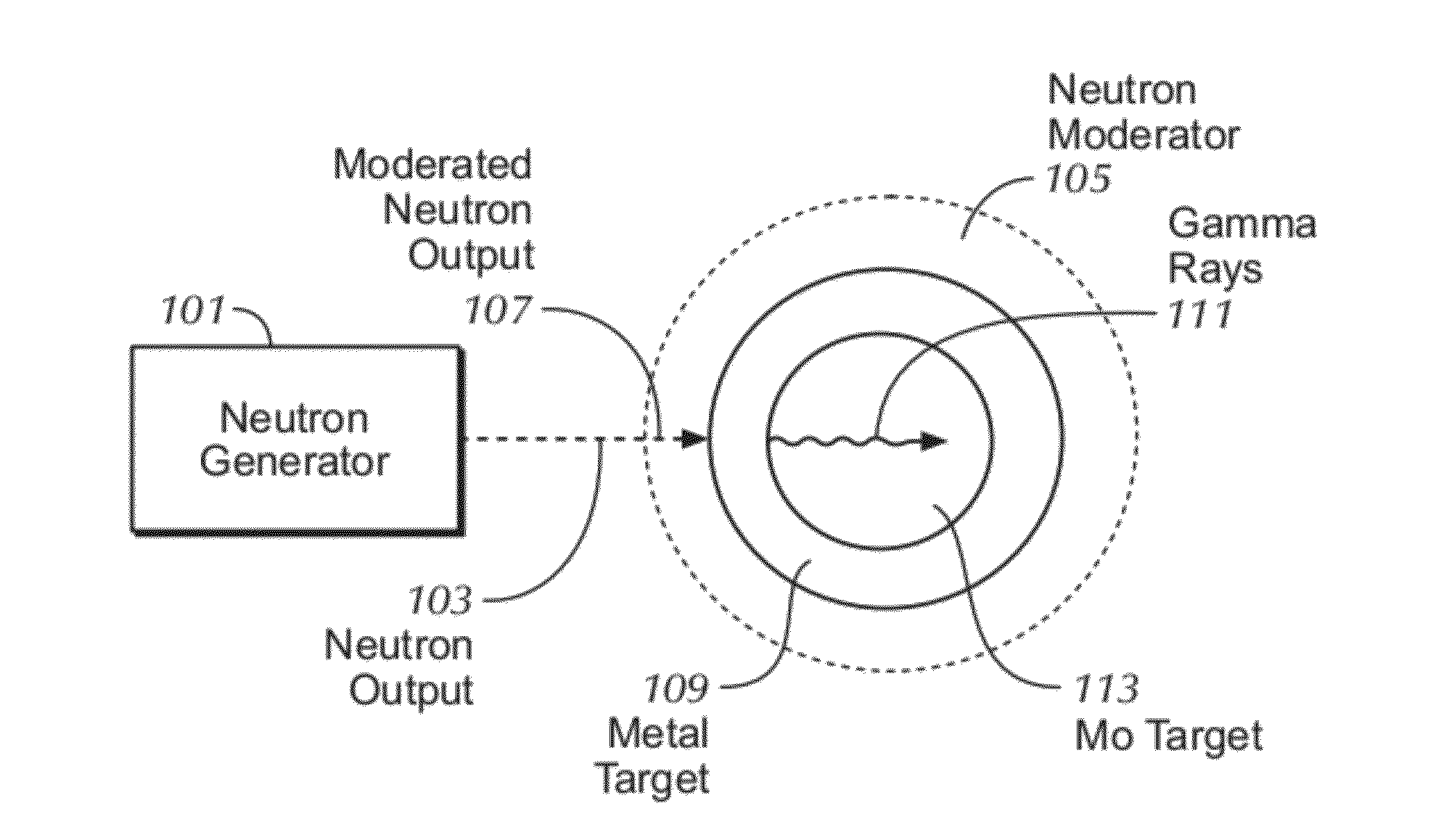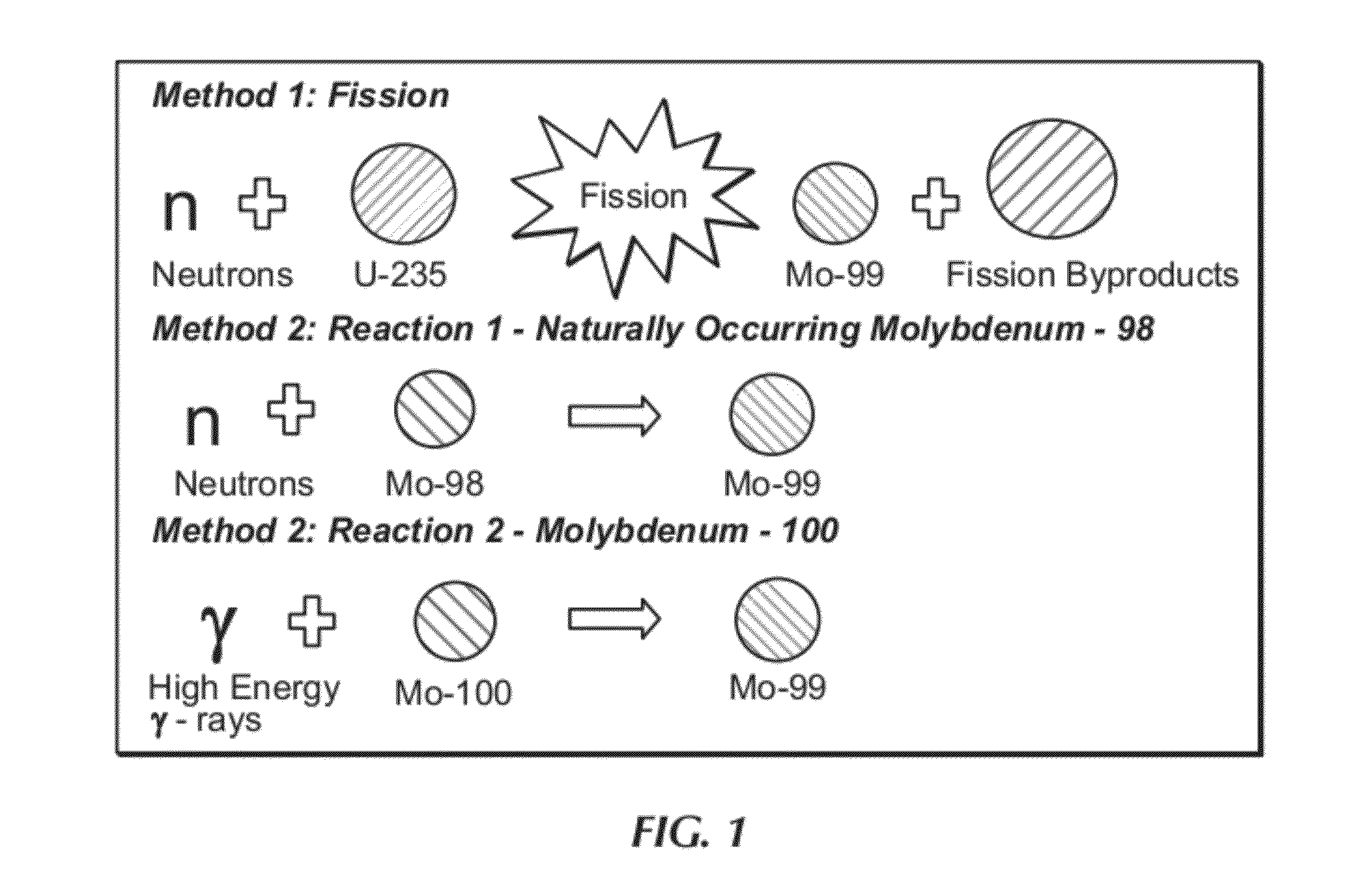Production of Radionuclide Molybdenum 99 in a Distributed and In Situ Fashion
- Summary
- Abstract
- Description
- Claims
- Application Information
AI Technical Summary
Benefits of technology
Problems solved by technology
Method used
Image
Examples
example 1
Configuration 1, Run 1
[0099]The laboratory was configured as depicted in FIG. 6 using shielding of the type, thickness and orientation as indicated in the figure. The targets of the test were 3 molybdenum coupons (Coupon Nos. 8, 9, and 10) each containing about 16 g of naturally occurring molybdenum. A D-T neutron generator was activated for 15.5 hours in the presence of the coupons. At the conclusion of the test the coupons were tested for radioactivity. The amount of radioactivity is indicative of the amount of molybdenum transformed into Tc-99m. The results are shown below in Table 1.
TABLE 1RunRunTimeCouponActivityActivityIdentification(hrs)No.WeightMicroCuries / gMicroCuriesConfig. 115.5816.034Run #1916.1331.6700E−052.6942E−041016.0532.4080E−033.8656E−02
example 2
Configuration 1, Run 2
[0100]The laboratory was configured as depicted in FIG. 7 using shielding of the type, thickness and orientation as indicated in the figure. The targets of the test were 3 molybdenum coupons (Coupon Nos. 37, 18, and 19) each containing about 16 g of naturally occurring molybdenum. A D-T neutron generator was activated for 16 hours in the presence of the coupons. At the conclusion of the test the coupons were tested for radioactivity. The amount of radioactivity is indicative of the amount of molybdenum transmutating into Tc-99m. The results are shown below in Table 2.
TABLE 2RunRunTimeCouponActivityActivityIdentification(hrs)No.WeightMicroCuries / gMicroCuriesConfig. 1163716.0251.0990E−031.7611E−02Run #21815.9621.4410E−052.3001E−041915.9667.6860E−061.2271E−04
example 3
Configuration 2
[0101]The laboratory was configured as depicted in FIG. 8 using shielding of the type, thickness and orientation as indicated in the figure. The targets of the test were 3 molybdenum coupons (Coupon Nos. 16, 22 and 32) each containing about 16 g of naturally occurring molybdenum. A D-T neutron generator was activated for 16 hours in the presence of the coupons. At the conclusion of the test the coupons were tested for radioactivity. The amount of radioactivity is indicative of the amount of molybdenum transformed into Tc-99m. The results are shown below in Table 3.
TABLE 3RunRunTimeCouponActivityActivityIdentification(hrs)No.WeightMicroCuries / gMicroCuriesConfiguration161615.9691.2840E−052.0504E−042215.9733215.886
PUM
 Login to View More
Login to View More Abstract
Description
Claims
Application Information
 Login to View More
Login to View More - R&D
- Intellectual Property
- Life Sciences
- Materials
- Tech Scout
- Unparalleled Data Quality
- Higher Quality Content
- 60% Fewer Hallucinations
Browse by: Latest US Patents, China's latest patents, Technical Efficacy Thesaurus, Application Domain, Technology Topic, Popular Technical Reports.
© 2025 PatSnap. All rights reserved.Legal|Privacy policy|Modern Slavery Act Transparency Statement|Sitemap|About US| Contact US: help@patsnap.com



